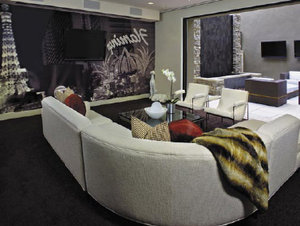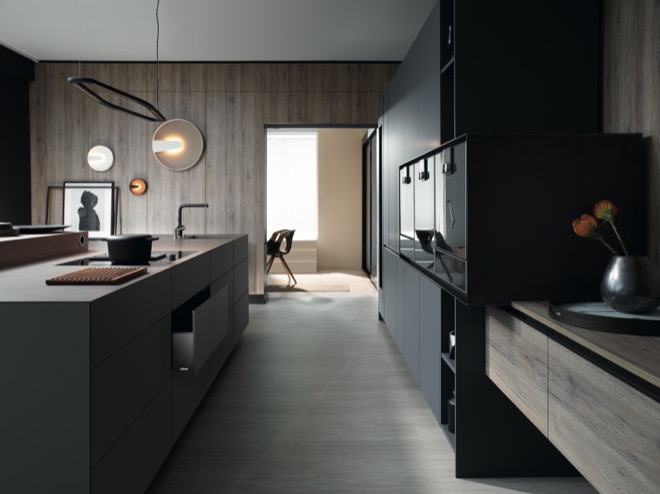When “The New American Home” was launched at the International Builders Show in Las Vegas this January, it came with no fewer than 10 fl at-panel, high-defi nition LCD televisions, 40 speakers built discreetly into ceilings and walls, and lots of Internet points. In contrast with the model unveiled only a mere decade ago — whose sole nod to technology was a “computer niche” — this year’s house would have given the Starship Enterprise a run for its money. Apart from full home networking managed via simple touchscreens or remotes, the 2009 home gave high-tech entertainment the starring role. In tandem with a cutting-edge home theatre, the home’s seamless access to music, media, television, movies — in fact any digital content — took leisure to a whole new level. It’s a sign that home entertainment is fast becoming a hybrid aff air as high-performance home cinema continues to deliver the immersive experience we crave, and wholehouse entertainment — available anytime, anywhere and on any gadget — starts to feel as normal as turning on the lights. “The way we receive and manage our digital content at home will never be the same again,” said Tucker Bernard, executive director of the National Association of Home Builders in the US, the group behind the annual New American Home.
All in the family
It’s a trend that’s already reshaping the way our homes and apartments look and, more importantly, how we behave in them. While we steadily grow used to a number of screens, speakers and data outlets in most rooms, we’re also starting to enjoy greater freedom about how, when and where we’ll consume a broad range of media. And that’s good news for everyone — particularly families — as leisure hours get squeezed, the boundaries between jobs, school and home get more porous, children live at home longer, and broadband begins to underpin nearly everything we do. clients to provide diversity when it comes to home cinema and entertainment,” said Don Mackenzie of Home Theatrix in Queensland. “Many of our customers have teens or young adult children still at home so you’re getting a real mix of interests starting to happen. Children are also introducing their parents to new technologies such as MP3 players or online video so we’re steadily adding in the technology to match that,” Don added. That was certainly a major interest for David Peaston and his wife when they renovated their Federation-style home in Sydney’s northern suburbs a few years ago. Not only did they put in a dedicated cinema upstairs in close proximity to their two teenage children’s bedrooms, they also made sure they could access movies and music from a number of zones around the house, including the outside terrace. “We were very keen to create a home where our teenage children could socialise with their friends even as they got older, but where we could also enjoy music and movies just as easily,” David said. “I have to say the technology has worked incredibly well as we all love using the home cinema, but can do separate things without intruding on each other. Our children don’t really watch television that much, but like watching things online or listening to music from an iPod, while we still like using CDs or catching up with the odd TV series. It’s great to have the choice.”
The way we live at home now
And they’re not alone, especially as our homes become something of an entertainment hub, capable of providing all things to all people. Squabbles over the remote, use of the home theatre or even access to a favourite TV program could soon be a distant memory as everyone in the family begins to mix and match entertainment to their technology of choice. For a start, while other leisure activities such as hobbies or sport have declined, we’re spending a lot more time on audiovisual media at home — up to two-and-a-half hours a day, according to the Australian Bureau of Statistics — and with women making one of the biggest jumps in the past decade. important sources of entertainment — we’re still watching more than three hours of television a day, it appears — a new survey by Nielson suggests TV just got overtaken by time online. However, it may not be as mutually exclusive as it sounds. We appear to be doing quite a lot of things while we’re using the web, including watching free-to-air or subscription television, playing DVDs and games, or listening to music via radio, CDs or iPods. The same Nielson survey found that 58 per cent of us watched TV and 48 per cent listened to radio, while online, in fact. And with broadband access now having soared to 4.3 million users here — that’s more than half of all Australian homes, watching downloaded video-based material on the PC — and increasingly on the smart phone — has also made a big jump. An IBM survey last year that included Australia found 81 per cent of people had watched or wanted to watch PC video, and an average of 42 per cent said they’ve watched or want to watch mobile video. And our love aff air with video is not just with traditional types of media either. One of the biggest sectors for home entertainment these days is in games, and Australians spent nearly $2 billion on video games and consoles in 2008, a rise of 47 per cent on 2007. Contrary to popular belief, gamers are no longer just adolescent boys either. A recent Bond University survey found nearly 70 per cent of Australians now play video games — with the average age of players 30 years — and with women now making up nearly half the gaming population.
Other rooms, other choices
Of course, delivering all that recreational mix at home — either in a dedicated room or in every room in the house — is never as simple as it sounds and requires serious planning. “You really have to sit down with clients and get them to think about their lifestyle, both as a family and separately,” Daniel King said from Intelligent Home in Perth, said. “Most people will have diff erent likes and dislikes when it comes to entertainment and technology, as well as preferences about how, when and where they want to enjoy it.” According to Daniel, greater fl exibility at home will become the norm, especially as more and more of us get good broadband speeds that can handle big digital fi les such as high-defi nition movies. And to handle it, he says, you need to be able create a networked home using a wired solution based on high-speed cables such as Cat 5 or Cat 6 in tandem with lots of data points for accessing the Internet. “Homes need technological capacity and that still only really comes over cable to be able to handle the need for speed and distribution to ultiple devices,” states Daniel. Typically, he tries to ensure entertainment nirvana by putting in either a media streamer to simply fi nd fi les and distribute them, or a more sophisticated media server that can actually surf the web and stores lots of fi les, from movies to songs. Increasingly, his company is also adding iPod docks in most rooms so clients can access their own playlists whichever room they happen to be in. “We’re seeing a lot more gadgets in homes these days; recently I worked in a home where there were 16 Internet-enabled devices such as TIVO, Apple TV, laptops, media servers and smart phones.” ‘
The all-multi-plex home
In fact, our appetite for home entertainment shows no sign of abating, particularly as we fi ll our homes with all sorts of fi xed and mobile screens, and media companies scramble to fi nd new ways to capture our interest in them. The phenomenal growth in Blu-ray — the high-defi nition format for video and movies — is a perfect example. Nearly a million Blu-ray high-defi nition movies have now been sold in Australia since becoming available roughly two years ago, and sales of Blu-ray players continued to boom last year even as the global recession started to bite. In fact, global market analyst, Screen Digest, expects the number of Blu-ray-enabled households in Australia to jump nearly 1000 per cent over the next four years, indicating we’ll buy a further six million high-defi nition televisions over that time. It’s been a similar picture worldwide as the embrace of Blu-ray proves to be one of the fastest consumer technologies of all time, surpassing even that former world champion, the DVD, in the uptake race. And while the boom in fl at-panel televisions has been a success story for some time — their sales increased by nearly a quarter in 2007 — it looks like other gadgets with screens are doing just as well. Smart phones that can connect to the Internet, and download digital material such as videos, ebooks and possibly movies in the not-too-distant future, are now the big must-have item. While Apple’s iPhone has undoubtedly stolen the show till now — more than a billion were sold worldwide last year and more than 200,000 in Australia by mid 2008 — there are a host of contenders in the wings including Google and the star of the Consumer Electronic Show in the US this year, the Pre by Palm. And if you think the written word is on the decline, then yet another form of screen, the e-book, will make you think again. Google, Apple and Amazon all have versions on the market, with Amazon’s latest version of the Kindle making a bid to be the iPod of books. Not only is Amazon planning to create e-books for mobile phones, but this newest version — with cleaner design, sharper screens and faster operability — suggests they may soon be an everyday item at home.
New entertainment, new families?
Debate about what impact home entertainment has on families is as old as television — or even radio — of course, and so it’s no wonder the boom in multiple avenues of media has begun to raise discussion. But it may be premature. One recent US study found around a quarter of people felt new technologies had brought their family closer together, while 60 per cent said it was no different to how they felt about their family life as they were growing up. Families also seem to fi nd a natural balance with their technology buys, with Pew also discovering that parents and teens tend to own a similar number of gadgets, but not always the same kinds. “The types of media and entertainment available to us at home these days has really multiplied over the past decade, and I don’t think we’re seeing any downside to all that variety,” said Jeff Brand, associate professor for Communication and Media at Bond University. “In fact, I think we’ve become a more active audience and all that choice isn’t taking away from the way we normally behave at home; it’s creating new opportunities to be together as a family. You only have to see how popular family video games like Wii Play or Wii Sport




